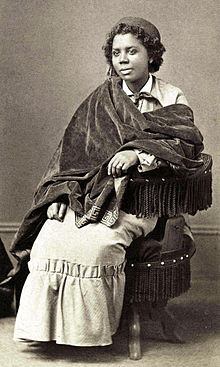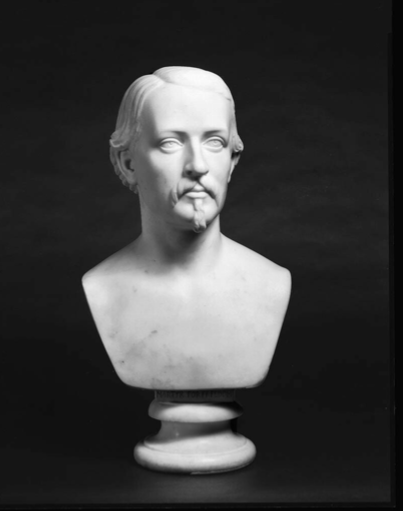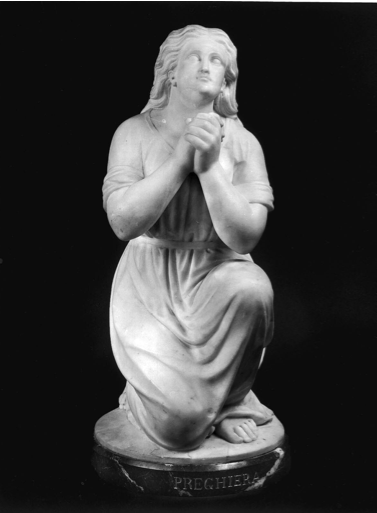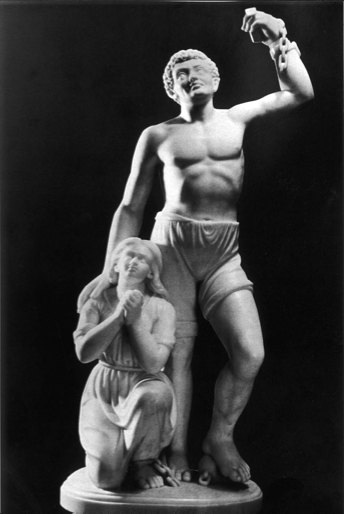

Queer Places:
Via Gregoriana, 7, 00187 Roma RM
Piazza Barberini, 8, 00187 Roma RM
Via di S. Nicola da Tolentino, 8, 00187 Roma RM
Studio Building, 110 Tremont St, Boston, MA 02108
St Mary, Harrow Rd, White City, London NW10 5NU, UK
 Mary Edmonia Lewis (c. July 4, 1844 – September 17, 1907) was an American
sculptor who worked for most of her career in Rome, Italy. A certain
homoeroticism emerged, made all the more remarkable by the fact that many
prominent artists of this era—including
Thomas Eakins,
F. Holland Day,
John Singer Sargent,
Harriet Hosmer,
Edmonia Lewis, and
Anne Whitney—had intense romantic
attachments with members of their own sex.
Mary Edmonia Lewis (c. July 4, 1844 – September 17, 1907) was an American
sculptor who worked for most of her career in Rome, Italy. A certain
homoeroticism emerged, made all the more remarkable by the fact that many
prominent artists of this era—including
Thomas Eakins,
F. Holland Day,
John Singer Sargent,
Harriet Hosmer,
Edmonia Lewis, and
Anne Whitney—had intense romantic
attachments with members of their own sex.
Lewis was the first woman of African-American and Native American heritage to achieve international fame and recognition as a sculptor in the fine arts world. Her work is known for incorporating themes relating to black people and indigenous peoples of the Americas into Neoclassical-style sculpture. She began to gain prominence during the American Civil War; at the end of the 19th century, she remained the only black woman who had participated in and been recognized to any degree by the American artistic mainstream.[1] In 2002, the scholar Molefi Kete Asante named Edmonia Lewis on his list of 100 Greatest African Americans.[2]
The community of talented women in Rome included artists whose lives and works have become well known in art-historical circles: Harriet Hosmer, Edmonia Lewis, Anne Whitney, and Vinnie Ream; and those whose reputations have remained (until now) buried in the historical record: Emma Stebbins, Margaret Foley, Sarah Fisher Ames, and Louisa Lander. In 1903, Henry James immortalized this community of American women sculptors in Rome by characterizing them as “that strange sisterhood of American lady sculptors who at one time settled upon the seven hills [of Rome] in a white marmorean flock.”
In the 1860s, Henry Wreford promoted a movement of women artists in Rome known as the 12 Star Constellation amongst whom were Charlotte Cushman, Margaret Foley, Harriet Hosmer, Edmonia Lewis, Emma Stebbins. Henry Wreford was a figure of curiosity for historians and literary experts of the time but remained relatively unknown to the wider public despite his substantial role within the political world of pre-unified Italy and his promotion of the culture of gender.
Edmonia Lewis met Anne Whitney in 1864, when they both worked in Boston’s Studio Building on Tremont Street. Like Lydia Maria Child, Whitney publicly supported Lewis’s sculptural career. Whitney seemed genuinely puzzled by this young woman—by her mixed Native American and black identity. “Edmonia is very much of an aboriginal,” she wrote to her partner, Abby Manning, “grateful, vengeful, a little cunning, and not altogether scrupulous about the truth when dealing with those she doesn’t love; open, kind and liberal as day with those she does. I like her in spite of her faults, and will help her all I can.”
Edmonia Lewis met Harriet Hosmer when the sculptor stopped by her studio in 1865 to see her Bust of Colonel Robert Gould Shaw. Suitably impressed with the work, Hosmer encouraged Lewis to visit her in Rome. After selling one hundred plaster copies of the Shaw bust at fifteen dollars apiece, Lewis earned enough money to fund her sojourn to Italy.

Edmonia Lewis, The Bust of Robert Gould Shaw, 1867, marble. Museum of African
American History, Boston and Nantucket, Mass.

Edmonia Lewis, Preghiera, 1866, marble. Collection of Kathryn Chenault,
courtesy of Conner-Rosenkranz, New York, and Peg Alston Fine Arts.

Edmonia Lewis, Forever Free, 1867, marble. Howard University Gallery of Art,
Washington, D.C.
After arriving in Italy in November of 1865, Edmonia Lewis first visited Florence, where she met the American sculptors Thomas Ball and Hiram Powers. In Rome, she was immediately greeted by Charlotte Cushman and Harriet Hosmer. She rented a studio once inhabited by the neoclassical sculptor Antonio Canova, the very studio that Louisa Lander had used during her abbreviated stay in Rome. She was in regular touch with Hosmer, visiting her new and luxurious studio on via delle Quattro Fontane. By 1867, she was living on via Gregoriana, in close proximity to Cushman, Hosmer, Whitney, and others in Rome’s Anglo-American women’s community.
In Rome she frequented a group of artists including Anne Whitney, Emma Stebbins, Harriet Hosmer, Louisa Lander, Margaret Foley, Florence Freeman, and Vinnie Ream.[8] Nathaniel Hawthorne was clearly describing these in his novel ''The Marble Faun'', and Henry James called them a "sisterhood of American ‘lady sculptors'."[9] At the time Hosmer was the companion of Charlotte Cushman, who later left her for Stebbins. In Rome, Lewis rented Antonio Canova's old studio, at Via Gregoriana, 7, near the Piazza Barberini, in close proximity to Cushman (who lived at #38), Hosmer, Whitney, and others in Rome's Anglo-American women's community, and remained there for almost two years. The studio was at ground level but carried its own cachet for having been the space of the most revered neoclassical sculptor in history. Lewis also would have frequented the studio of her fellow sculptors.
In 1866 the Englishman Henry Wreford, a freelance correspondent in Italy, described the female artists in Rome collectively as “a fair constellation . . . of twelve stars of greater or lesser magnitude, who shed their soft and humanising influence on a profession which has done so much for the refinement and civilization of man.” Some of Wreford’s twelve stars, incidentally all American sculptors, are still recognizable names even today: Margaret Foley, Florence Freeman, Harriet Hosmer, Edmonia Lewis, and Emma Stebbins. Less known now are the American painter sisters Mary Elizabeth Williams and Abigail Osgood Williams, the Italian sculptor Horatia Augusta Latilla Freeman and her relative, the painter Adah Caroline Latilla, Irish painter and sculptor Jane Morgan, and English sculptor Isabel Cholmelay (her studio was at Palazzetto Sciarra). It is not entirely clear which of these women produced art of “greater magnitude” in Wreford’s mind; his discussion is rather general overall. Indeed, in his article and in others of the period, even the better-known women tend to earn more comments about their personalities, appearances, or behaviors than about their art.
Henry T. Tuckerman, an American writer who lived in Italy, included a brief section on American female sculptors in Rome in his Book of the Artists (1867). In less than five pages, in a volume of more than 600 pages total, he discussed several members of Henry Wreford’s constellation, including Margaret Foley, Florence Freeman,[9] Harriet Hosmer, Edmonia Lewis, and Emma Stebbins. He briefly mentioned Sarah Fisher Clampitt Ames, Louisa Lander, Vinnie Ream, and Anne Whitney, though by that date Lander and Ames had returned to the United States and Ream had not yet arrived in Rome. Tuckerman’s description was hardly complementary; he noted that public appreciation of their art seemed to derive from “national deference to and sympathy with the sex” and from a lack of understanding about art in general. Yet even his dismissive analysis shows awareness of and interest in these women and their activities.
Among the first works that Lewis produced in Rome were three neoclassical sculptures that brought attention to the contemporary freedwoman: Preghiera (Prayer) of 1866, Freedwoman and Child of 1866, and Forever Free of 1867.
In the spring of 1867, Anne Whitney and Abby Adeline Manning were in Rome. They took an apartment and an hillside studio not far from Edmonia Lewis' rooms on the Via Gregoriana. Lewis promptly invited them to visit her in the studio once graced by Harriet Hosmer, John Gibson, and, most notable, Antonio Canova.
From the fall of 1867 through the 1870s, Lewis rented #8 and then #9 Piazza Barberini. Beyond the bevy of art-seekers, her new studio had an edge over the forbidding gate of her old Canova space and the up-stairs studios of so many rivals. An expensive glass door invited passing tourists to peer inside, perhaps to enter. For rivals and keepers of old biases, it was one more cinder in their resentful eyes.
In 1873 Lewis' studio was at Via San Nicolò Tolentino, 8.
Lewis never married and had no known children.[62] Her half-brother Samuel became a barber in San Francisco, eventually moving to mining camps in Idaho and Montana. In 1868, he settled in the city of Bozeman, Montana, where he set up a barber shop on Main Street. He prospered, eventually investing in commercial real estate, and subsequently built his own home which still stands at 308 South Bozeman Avenue. In 1999 the Samuel Lewis House was placed on the National Register of Historic Places. In 1884, he married Mrs. Melissa Railey Bruce, a widow with six children. The couple had one son, Samuel E. Lewis (1886–1914), who married but died childless. The elder Lewis died after "a short illness" in 1896 and is buried in Sunset Hills Cemetery in Bozeman.[8]
She lived in the Hammersmith area of London, England, before her death on September 17, 1907, in the Hammersmith Borough Infirmary.[63] According to her death certificate, the cause of her death was chronic Bright's disease.[64] She is buried in St. Mary's Roman Catholic Cemetery, in London.[65]
There were earlier theories that Lewis died in Rome in 1907 or, alternatively, that she had died in Marin County, California, and was buried in an unmarked grave in San Francisco.[66]
In 2017, a GoFundMe by East Greenbush Town Historian Bobbie Reno was successful, and Edmonia Lewis's grave was restored. The work was done by the E M Lander Co. in London.
My published books: